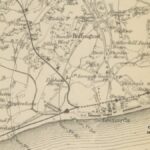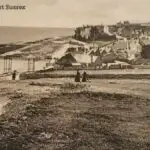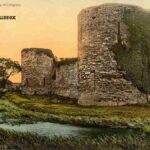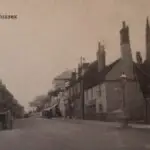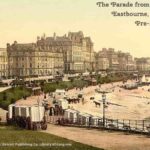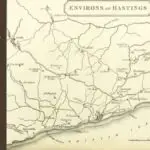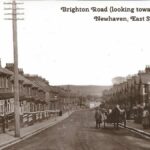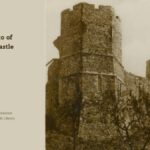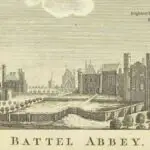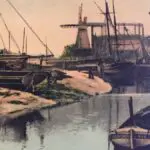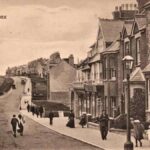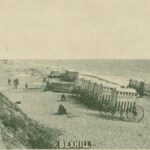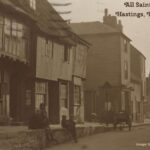Glimpse history through old images of Rottingdean, East Sussex, England.
Fokker Gliding 1922
Black and white silent footage from 1922 shows Anthony Fokker (a Dutch inventor and famous aviation pioneer) attracting a large crowd of spectators as he pilots a glider.
Fokker gliding at Rottingdean (1922) – British Pathé on YouTube
Toy Museum 1960
Mrs Yootha Rose, curator of The Toy Museum at Rottingdean, demonstrates some of the mechanical toys on display.
Toy Museum (1960) – British Pathé on YouTube
A Bit of Rottingdean History
Extract from: The History and Antiquities of Lewes and Its Vicinity. … With an Appendix Containing an Essay on the Natural History of the District, by G. Mantell. [With Plates and a Supplement.] Volume 2, by Thomas Walker HORSFIELD
Published in 1827
Pages 208-210
THE parish of Rottingdean , which is altogether upon the South Downs ,
is in its form very irregular . It may contain altogether a little more
than 3000 acres of arable and pasture land . It is bounded on the west by
Falmer and Ovingdean ; on the east by Rodmill , Southese , and Telscombe ;
on the north by Kingston , and on the south by the British channel . The
village is situated in a valley of the Downs , about four miles eastward from
Brighton , as many west from Newhaven , and seven , S.S.W. , from Lewes . It
is a pleasant marine village , and has of late been the resort of many visitors ,
who preferred the serenity of this retired spot to the bustle and excitement of
Brighton . The machines for sea bathing are not , as in that fashionable place ,
exposed to the rude gaze of every passenger , but , sheltered by the tall cliff ,
the visitor may , in privacy , enjoy the advantage and luxury of sea bathing .
Besides the convenience of machines , private baths of various descriptions
have been established in the village . There are some excellent lodging – houses ,
both fronting the sea , and in more sheltered situations .
” The beach , near this place , contains semi – translucent pebbles of agate and
chalcedony , of a blueish grey colour . These are collected by visitors , and
when cut and polished , are used for bracelets , and other ornamental purposes :
they are usually called ‘ Rottingdean pebbles . ” ” *
The road from Rottingdean to Brighton is delightfully pleasant in the
summer season , but terrific when the storms of winter rage . The greater part
Footnote:
‘ In attempting the derivation of this name ,
Mr. Elliott has the following observations , which ,
though they may not be convincing , are at any
rate ingenious : – ” From the Saxon Rade , or
Rading , a road , roding , incursion or invasion ,
and Dene , a valley . The road from Rotting
dean enters the town of Lewes at a street or
way , called Rotting Row , or Ru : Rue is a
Celtic word for Street , and is still so called in
the modern French ; and the Celtic verb Rhodio ,
is to ride or journey . And as Newhaven was
guarded by an old castle at its entrance , it is
not improbable that both the Saxon , and subse
quent Danish invasions of the town and country
about Lewes , might be effected by landing on
the shore at Rottingdean , and pursued along the
valley by Balsdean , ( or Ballisden , which signi
fies the vale of fire , or burning of dead bodies ;
for it was the Roman British custom to burn
their dead , and bury the burnt bones in urns ) ;
for this way they avoided the old Roman fort
at Swanberge , or Swanborough , thrown up as
a guard for the post road from Newhaven to
Lewes ; as also another fort for the same pur
pose , situated in the castle field , between Pid
dinghoe and Deans ; and a third fort or Roman
camp , at Telscombe , easily manned on sudden
alarms . ” For an account of the descent of the
French , at Rottingdean , and their defeat by the
prior of Lewes , in the reign of Richard II . , see
Vol . I. , p . 159 .
Mantell’s Fossils of the South Downs , p . 82 .
of the cliff , near to the edge of which the old road ran , is unguarded by railing or
ditches of any kind , so that the least deviation from the beaten track , presents
to the spectator a perpendicular cliff , on an average 200 feet in height , at
the base of which the angry sea is beating . Many dreadful accidents have
occurred to benighted travellers , who , imperceptibly wandering from the
direct road , have been precipitated from the elevated rock into the gulph
beneath . Amongst the list of sufferers may be placed the Rev. Mr. Weston ,
curate of Rottingdean ; Mr. Hart , milliner , Piccadilly ; and Mr. Lindsey , cus
tom – house officer , of Rottingdean . About four years ago , two tradesmen ,
returning in a gig from Newhaven to Brighton , in the evening , ventured too
close to the edge of the cliff : on endeavouring to ascend a little rise in the
road , the horse ran back ; the wheels of the gig passed over the brink of the
cliff , and dragged after it the animal : the men and horse were next morning
found lifeless , and the gig dashed to pieces . It is but right to say , that since
the last – mentioned occurrence , a new line of road has been planned between
Brighton and Rottingdean , which leaves the sea considerably to the south .
From this place , eastward , the chalky cliff gradually encreases in elevation , till
the traveller reaches Beachy Head , which rises from the bosom of the ocean to
a perpendicular height of 500 feet .
The manor of Rotingedene is mentioned in Domesday as being held of William
de Warren , by Hugh . It is placed in the hundred of Welesmere . Formerly
it was the possession of Earl Godwin , and was assessed at two hides . From
the time of Edward the Confessor , to the formation of Domesday , its value
had varied from 40 to 20 , and again to 60s .
The manor farm of Balsdean lies in the parish of Rottingdean . It belonged
to St. Pancras ‘ Priory , Lewes , and was granted , at the dissolution , to Thomas ,
Lord Cromwell . In 1 Elizabeth , Thomas Gratwick was found seized . In the
following year , it was disposed of to Agnes Gratwick , his mother : it was then
stated to include pasture for 600 sheep on the demesne , and was held of the
Queen by one – fortieth part of a knight’s fee . In 6 James , Sir Anthony Sherley
claimed the whole farm of Ballesdean , ( by letters patent ) consisting of 262 acres ,
herbage for eight oxen on the down , and for six heifers . In 22 Charles II . ,
Walter Burrell , Esq . , of Cuckfield , gave by will , to his sons , Thomas , Timothy ,
and Alexander , his messuage , farm , & c . , of Balsdean , and other property , for
the maintenance and education of his grandson , Walter , eldest son of Ninian
Burrell , Esq . In 1782 , Balsdean farm consisted of about 1000 acres of land ,
tythe free , and an adjoining farm of 100 % . per annum , called Norton , paid all its
great tythes to it . The whole let at 330 % . per annum .
A Roman dagger was , in 1757 , found on opening a tumulus at Balsdean .
The ecclesiastical living is an undischarged vicarage in the deanery of Lewes .
The vicarage was endowed by Seffrid , the second Bishop of Chichester ; for an
account of which , see Appendix II . In Pope Nicholas , the vicarage was rated
at 15 , and the church at 20 marks . In the King’s books it is valued at 91. 10s .
The church , dedicated to St. Margaret , is an ancient structure , and was
originally much larger than at present . A few years ago it underwent a compleat
repair , and at the present time exhibits one of the neatest interiors to be met
with in the neighbourhood . The ancient chancel is separated from the body of
the church by folding doors , which are adapted to the large gothic arch , which
formed the entrance . There are no monuments or inscriptions deserving of
notice .
In the church – yard is the following inscription- ” To the memory of Mr. William Knight , who
departed this life Nov. 29 , 1784 , aged 60 years . Also , of Abigail , his wife , who departed this life
Feb. 21 , 1797 , aged 71 years .
” Beyond this vale of tears our treasure lies ,
And hope still blossoms , though frail nature dies ;
Beyond this dark recess of worms and dust ,
Immortal honours crown the good and just .
The humble spirit , ready to depart ,
Feels not a pang from Death’s triumphant dart ;
The humble spirit , all its frailties o’er ,
Meets smiling Mercy on th ‘ eternal shore ;
With healing wing she guards its trembling flight ,
To the blest regions of celestial light . “
On a tombstone , also in the church – yard , in capitals :
” GREAT AARON’S SONNE , ONE OF THE LEVITE’S TRAINE ,
LIES HERE WITH COMFORT FOR TO RISE AGAIN ;
A MAN OF PEACE , THE POORER PEOPLE’S FRIENDE ,
A FAITHFUL ABRAHAM LIVED , AND MADE AN ENDE .
SEPT . 4 , 1619 .
WI . SAVAGE , VICAR OF THIS PLACE , AND PARSON OF
OVINGDEAN . “
INCUMBENTS
Sir John Knoll ………. died 1558
William Savage…died 1619
Robert Adyn….died 1627
Robert Baker…. died 1679
Isaac Woodruffe….ind1687
Thomas Pelling ………. died 1732
Walter Bartlett ….died 1743
Thomas Curteis …ind 1751
William Allen….ind 1755
Thomas Hollingberry….ind 1771
T. R. Hooker ….ind 1792
POPULATION
1801 …… 275 Males …. 268 Females …. 543 Total …. 102 Families …. 106 Houses
1811 ….. 261 Males …. 298 Females …. 559 Total …. 116 Families …. 123 Houses
1821 …… 301 Males …. 411 Females …. 772 Total …. 156 Families …. 165 Houses
More about East Sussex
- Old Images of Wannock, East Sussex
- Old Images of St Leonards-on-Sea, East Sussex
- Old Images of Crowhurst, East Sussex
- Old Images of Rottingdean, East Sussex
- Old Images of Pevensey, East Sussex
- Old Images of Hailsham, East Sussex
- Old Images of East Sussex, England
- Old Images of Winchelsea, East Sussex
- Old Images of Newhaven, East Sussex
- Old Images of Lewes, East Sussex
- Old Images of Crowborough, East Sussex
- Old Images of Battle, East Sussex
- Old Images of the Pestalozzi Children’s Village, Sedlescomb
- Old Images of Rye, East Sussex
- Old Images of Seaford, East Sussex
- Old Images of Sidley Green, East Sussex
- Old Images of Bexhill-on-Sea, East Sussex
- Old Images of Hastings, East Sussex
- Old Images of Eastbourne, East Sussex
- Old Images of Brighton And Hove



